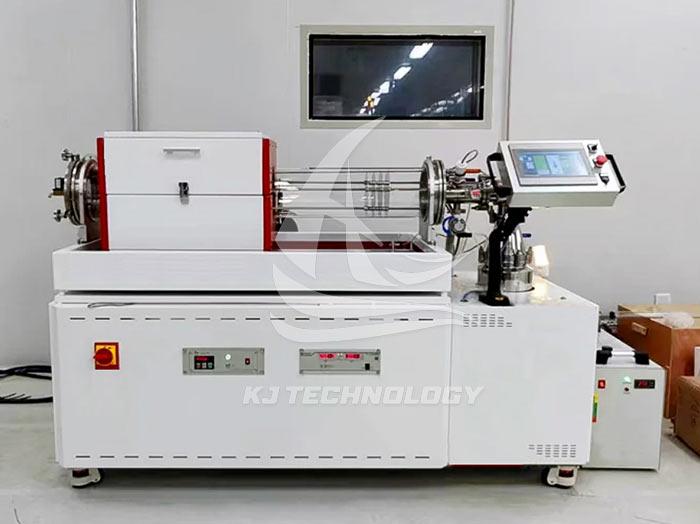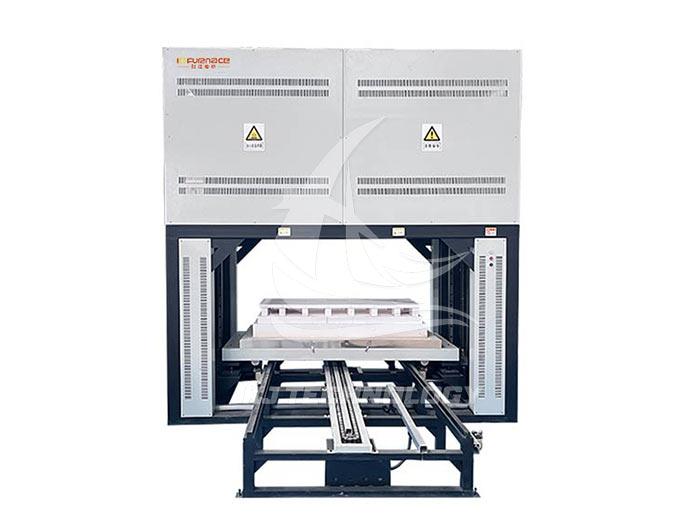Precautions for using diffusion welding vacuum furnace
 08-18-2025 Author: KJ technology
08-18-2025 Author: KJ technology
As a high-precision heat treatment equipment, the diffusion welding vacuum furnace must strictly follow the operating specifications to ensure process stability, equipment life, and personnel safety. The following is a detailed classification explanation of key precautions:
1. Preparation before operation
Equipment inspection
Vacuum system: Check the oil level and quality of the vacuum pump (whether it is emulsified or contaminated), test the linkage performance between the mechanical pump and the diffusion pump, and ensure that the vacuum degree meets the process requirements (such as 6.7 × 10 ⁻ ³ Pa).
Heating system: Verify the integrity of the heating element (such as graphite heating element) and calibrate the temperature sensor accuracy with an infrared thermometer (error ≤± 5 ℃).
Cooling system: Confirm the cooling water flow rate (usually ≥ 5L/min) and water pressure (0.2~0.3MPa), and check whether the water pipe joints are leaking.
Pressure system: Test the sealing of hydraulic or pneumatic devices to ensure stable pressure during pressurization (fluctuation ≤ ± 0.5MPa).
Workpiece pre-processing
Cleanliness: Use acetone or alcohol to clean the oil stains and oxide scales on the surface of the workpiece, and the roughness should meet the process requirements (such as surface roughness ≤ Ra0.8 μ m during diamond brazing).
Assembly accuracy: Check the gap between workpieces (usually ≤ 0.1mm) to avoid welding defects (such as lack of fusion and porosity) caused by improper assembly.
Material compatibility: Confirm the chemical compatibility between the workpiece, brazing material, and fixture (such as avoiding direct contact between copper based brazing material and aluminum substrate to produce brittle phases).
Process parameter setting
Temperature curve: Set segmented heating programs according to the material type (such as diamond brazing: room temperature → 600 ℃ (preloading) → 950 ℃ (brazing) → 600 ℃ (insulation) → room temperature).
Vacuum degree: During the high vacuum stage, continuous pumping should be carried out to the target value to avoid pressure relief and oxidation (such as when brazing diamond, the vacuum degree should be ≤ 1 × 10 ⁻ ² Pa).
Pressure loading: Adopt gradient pressurization method (such as 0 → 5MPa → 10MPa → 15MPa) to avoid deformation of the workpiece caused by instantaneous high pressure.
2. Monitoring during operation
Vacuum maintenance
Real time monitoring of vacuum gauge readings. If the vacuum degree decreases (such as>1 × 10 ⁻¹ Pa), the machine should be stopped immediately to check for leaks (commonly found at flange connections and observation window seals).
Avoid opening the furnace door in a vacuum state to prevent air from entering and causing oxidation of the workpiece (such as diamond graphitization).
Temperature uniformity control
Monitor the temperature distribution inside the furnace through thermocouples or infrared thermometers to ensure a temperature difference of ≤ ± 10 ℃ (large furnace bodies require zone temperature control).
Prevent local overheating (such as heating elements being too close to the workpiece) and avoid thermal stress cracking of the workpiece.
Dynamic adjustment of pressure
Adjust the pressure in real-time based on the deformation of the workpiece (such as increasing pressure in the high-temperature section to compensate for thermal expansion during graphite welding).
Avoid sudden pressure changes (such as dropping directly from 10MPa to 0MPa) to prevent workpiece rebound or solder cracking.
exception handling
Vacuum fault: Immediately turn off the heating power, start the backup vacuum pump, and wait for the vacuum degree to recover before reheating.
Temperature out of control: Cut off the heating power and activate the emergency cooling system (such as nitrogen purging) to prevent the workpiece from overheating and being scrapped.
Abnormal pressure: Release the pressure to a safe value and check for hydraulic system leaks or blockages.
3. Post operation maintenance
Workpiece processing
After welding is completed, wait for the furnace temperature to drop below 100 ℃ before opening the furnace door to avoid cracking of the workpiece due to thermal stress.
Use non-metallic tools to remove the workpiece to prevent scratching the inner wall of the furnace (such as graphite felt, mullite insulation layer).
Equipment cleaning
Furnace cleaning: Use a vacuum cleaner or soft bristled brush to remove solder splatters and graphite dust (avoid scratching with metal tools).
Observation window cleaning: Wipe the glass surface with alcohol to ensure a light transmittance of ≥ 90%.
Waterway emptying: In winter, residual water in the cooling water pipes needs to be emptied to prevent freezing and cracking (especially in northern regions).
regular maintenance
Vacuum pump oil replacement: Replace every 2000 hours of operation, while cleaning the oil circuit filter.
Heating element detection: Use a megohmmeter to test the insulation resistance (≥ 10M Ω) every six months to prevent leakage.
Seal replacement: Replace the furnace door seal ring (such as fluororubber ring) every 3 years to ensure vacuum sealing.
4. Safety regulations
personal protection
Wear heat-resistant gloves and goggles during operation to avoid high temperature burns or splash injuries.
Warning signs should be set up around the vacuum furnace to prohibit unrelated personnel from approaching.
Electrical safety
The grounding resistance of the equipment should be ≤ 4 Ω, and the insulation layer of the power line should be checked regularly for damage.
Avoid operating in humid environments to prevent electrical short circuits.
emergency measures
Equip fire extinguishers (such as carbon dioxide fire extinguishers) and first aid kits, and regularly organize safety drills.
Operators need to receive professional training and be familiar with the emergency shutdown process of the equipment.








